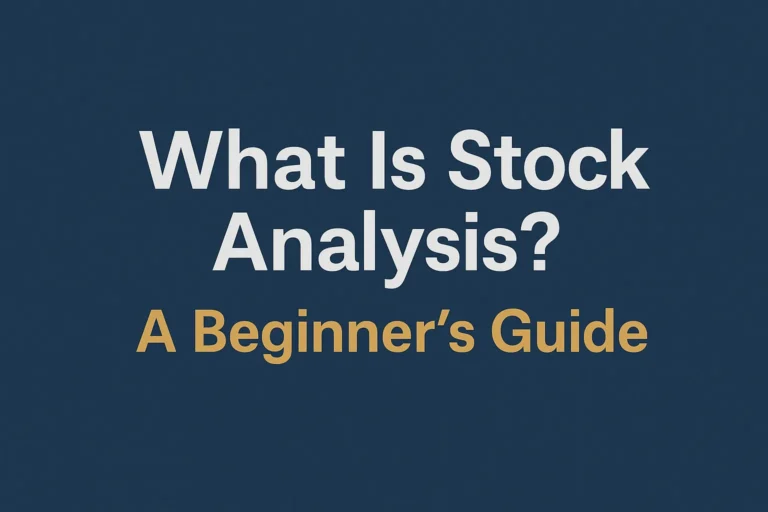How to Analyze a Stock Before Buying
Investing in a stock without proper research is like flying blind. Whether you’re a beginner or an experienced investor, performing a stock analysis before buying helps you avoid bad investments and build long-term wealth. In this guide, we’ll walk you through a simple, step-by-step process to analyze any stock effectively.
Step 1: Understand the Company’s Business Model
Start with the basics—know what the company does:
- What product or service does it offer?
- Who are its customers and competitors?
- Is the business model sustainable and scalable?
Use the company’s official website or investor presentations to learn the basics.
Step 2: Review the Company’s Financial Health
Go through key financial statements:
- Income Statement – Is the company profitable? Look for revenue and earnings growth over 3–5 years.
- Balance Sheet – Check assets, liabilities, and debt-to-equity ratio.
- Cash Flow Statement – See if the company is generating free cash flow.
Tools like Yahoo Finance, MarketWatch, or Simply Wall St simplify this step.
Step 3: Analyze Key Financial Ratios
Evaluate the company’s performance and valuation using these metrics:
| Ratio | What It Tells You |
|---|---|
| P/E Ratio | Is the stock over- or undervalued vs. peers? |
| ROE (Return on Equity) | How efficiently does it use shareholder money? |
| Debt-to-Equity | Is the company financially stable? |
| Current Ratio | Can it cover short-term liabilities? |
| EPS Growth | Is it increasing earnings consistently? |
Compare these with industry benchmarks.
Step 4: Study Industry and Sector Trends
Even a great company can underperform in a struggling sector. Ask:
- Is the industry growing or contracting?
- Are there regulatory or macroeconomic risks?
- How does the company compare to its peers?
Use tools like Finviz and sector ETFs to gain context.
Step 5: Evaluate the Competitive Advantage (Moat)
A strong competitive moat can protect a company’s profits. Look for:
- Brand loyalty
- Network effects
- Patents or proprietary tech
- Cost leadership
Companies with durable moats often outperform over the long term.
Step 6: Look at Valuation
Compare the current stock price to the company’s intrinsic value using:
- P/E Ratio
- PEG Ratio
- Price-to-Book (P/B)
- Discounted cash flow (DCF) models (advanced)
Avoid buying overvalued stocks without high growth potential.
Step 7: Review Recent News and Catalysts
Check for:
- Recent earnings reports
- Product launches or expansion
- Mergers and acquisitions
- Regulatory or legal issues
These can significantly impact short-term stock performance.
Step 8: Assess the Management Team
Strong leadership can make or break a company:
- Check CEO and executive track record
- Look for insider ownership (alignment with shareholders)
- Review shareholder letters or earnings call transcripts
Step 9: Check Technical Trends (Optional)
For better timing, consider basic technical analysis:
- Price trend (is it near 52-week high or low?)
- Support and resistance levels
- 50-day and 200-day moving averages
Use charts on TradingView or Yahoo Finance for quick visual analysis.
Step 10: Make an Informed Decision
Based on your research:
- Is the stock worth buying now?
- What’s your target entry and exit price?
- What’s your time horizon and risk level?
Avoid emotional decisions and stick to your strategy.
Conclusion
Analyzing a stock before buying doesn’t have to be complicated. With a structured approach—looking at fundamentals, valuation, trends, and management—you can make smarter investing decisions. Over time, consistent analysis builds confidence and improves your portfolio results.
FAQs
1. How long should I spend analyzing a stock?
For a new company, 1–2 hours of deep research is ideal. For known names, a quick refresh may be enough.
2. What are the best free tools to analyze stocks?
Yahoo Finance, TradingView, Finviz, and Simply Wall St are beginner-friendly and free.
3. Can I analyze stocks without knowing accounting?
Yes. Focus on basic financial metrics and visual tools to simplify the process.
4. Should I use both fundamental and technical analysis?
Yes, especially for timing entries. Fundamentals tell you what to buy, technicals tell you when to buy.
5. What is the most important ratio to check?
P/E ratio and ROE are two of the most commonly used metrics for beginners.


